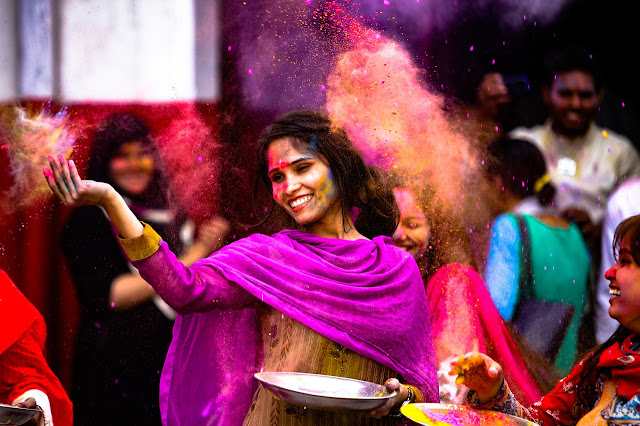The Color Used in Psychology, Cultural, and Religion
Colors possess a remarkable ability to influence our emotions, behavior, and even our physiological responses. The philosophy of color studies the meaning behind vibrant hues, exploring the psychological and cultural associations they hold. Each color carries a unique symbolism that can have a profound impact on our lives, from the calming effect of blue that brings peace to our souls to the energizing power of red that ignites our passions. This article aims to explore the immense potential of colors to inspire and enrich our lives, and how we can use them to better connect and communicate with others.
The influence of colors on human thoughts and emotions has been a subject of great interest in the field of color psychology. The study of color psychology involves an examination of how different colors can impact an individual's feelings, behaviors, and perceptions. Each color has its unique psychological associations and can elicit specific reactions from individuals. Thus, an understanding of the psychological impact of colors is of utmost importance to designers, marketers, and anyone who seeks to create a specific emotional response through the use of color. By comprehending the powerful influence of color on human psychology, professionals can effectively utilize color to achieve their desired outcomes.
Cultural connotations of colors vary across cultures. For instance, in Western cultures, white is often associated with purity, whereas in Eastern cultures, it more commonly symbolizes mourning. Similarly, while red is often seen as a symbol of good luck in Chinese culture, in Western cultures, it may be associated with danger. These cultural nuances are critical to consider when using colors in design, marketing, or any cross-cultural communication. Therefore, it is imperative to be aware of these cultural meanings and their significance to ensure effective communication across cultures.
The symbolic meanings of colors in religions have significant cultural and societal implications. For instance, in Christianity, white represents purity and divinity, while purple signifies royalty and spirituality. Similarly, saffron is considered sacred and associated with purity and fire in Hinduism. These color associations have a profound impact on understanding the world and expressing religious beliefs and values. Therefore, gaining insight into the symbolic meanings of colors in religion is vital for comprehending various cultural and social contexts.
The effects of colors on human emotions and moods have been widely studied. Warm colors such as red, orange, and yellow are known to evoke feelings of happiness and energy, while cool colors like blue and green tend to create a sense of calmness and relaxation. The use of colors in various settings can have a significant impact on mood and overall experience. For instance, restaurants may utilize warm colors to foster a lively ambiance, while hospitals may opt for cool colors to create a soothing environment. A comprehensive understanding of color associations can help to create desired experiences and optimize the ambiance of a given setting.
Theory of Color in Design Marketing and Branding Advertising
The subject of color theory is concerned with the study of how colors interact and combine to create visually appealing compositions. It is of utmost importance for designers and marketers to possess a thorough understanding of color theory, as it plays a crucial role in guiding the viewer's eye and enhancing user experience. Moreover, in the world of marketing, color theory is commonly utilized to elicit emotional responses, as well as to influence consumer perceptions and behaviors.
Colors have a pivotal role in branding and advertising, as they aid in establishing recognizable and memorable brand identities that strike a chord with consumers. This is exemplified by the successful utilization of red by Coca-Cola and golden arches by McDonald's, which have become synonymous with their respective brands. The strategic employment of colors can effectively convey a brand's personality, values, and positioning. For instance, green is often adopted by eco-friendly and sustainable brands, whereas purple is commonly associated with luxury and sophistication.
In advertising, colors are employed to seize attention, generate visual interest, and effectively communicate key messages. Advertisers may opt for colors that align with the preferences and aspirations of their target audience, thereby enabling them to captivate attention and evoke the desired response.
Color Combinations and Their Effects
The emotional and perceptual impact of color combinations is a significant aspect of design and marketing. Different combinations can create various effects, such as harmony, contrast, or specific moods. The choice of color combination is paramount to enhance visual appeal, communicate messages, and establish a memorable brand identity. Complementary colors, for instance, create high contrast, whereas analogous colors create harmony, and triadic colors create balance. Therefore, selecting the right color combination is crucial for effective communication in the world of design and marketing.
Color Preferences and Personal Interpretations
The preferences and meanings associated with colors can be influenced by various factors such as personal experiences, cultural backgrounds, and physiological aspects. In the context of design and communication, it is crucial to acknowledge the individual perceptions and preferences of people regarding colors to create experiences that establish a deeper connection and resonate with them on a personal level. Employing a tailored approach that recognizes these factors can lead to a more effective and engaging communication strategy.
The Meaning of Each Color
Colors hold significant power, capable of influencing our perceptions, evoking emotions, and conveying messages. This article aims to delve into the psychological and cultural associations that imbue each color with symbolism and significance. From the passionate energy of red to the calming tranquility of blue, this exploration of colors aims to comprehend how they shape our perceptions and experiences. Together, let us embark on a colorful journey to understand the psychology behind these shades.
Red
The color red is a prominent hue that attracts attention and is often associated with strong emotions such as love, anger, and passion. Red is considered a symbol of power and courage in many cultures, and it exudes energy and vitality, making it an excellent choice for creating a sense of urgency or excitement. Additionally, red is known to stimulate the appetite, which is why it is frequently used in the food industry. However, red can also have negative connotations related to danger, aggression, and violence. In certain cultures, it serves as a warning sign and is employed to caution individuals in hazardous situations. Incorporating red into designs or messaging necessitates an understanding of its context and cultural significance.
Blue
The color blue is often associated with a sense of calmness, tranquility, and serenity, making it a popular choice for creating a relaxing ambiance. Moreover, blue is also linked with trust, loyalty, and stability, which financial institutions leverage to instill a sense of security among their patrons. However, blue can also elicit feelings of sadness and melancholy if not used judiciously. Therefore, it is imperative to strike the right balance when incorporating blue in your branding or designs to avoid conveying an unwelcoming or distant vibe. Additionally, the shade of blue employed can also influence the emotional response it generates in the viewer. For example, lighter blues tend to be more refreshing and calming, while darker blues can be more introspective and mysterious.
Yellow
The color yellow is often associated with attributes such as happiness, optimism, and energy. It is often linked to sunshine and warmth and is known to elevate moods and create a sense of positivity. However, yellow may also be interpreted as representing caution and cowardice in certain contexts. It is important to be mindful of the cultural associations when incorporating yellow in designs or messaging. Yellow is frequently utilized to attract attention, which is why it is commonly seen in warning signs and road markings. In some cultures, yellow is considered a sign of luck and prosperity, while in others, it may carry negative connotations. Therefore, when using the color yellow, it is crucial to consider its cultural significance and implications.
Green
The color green embodies several positive attributes such as growth, harmony, and nature. Its association with a sense of calm and balance makes it an ideal choice for creating a relaxing and rejuvenating ambiance. Additionally, green is linked with fertility and abundance, though in some cultures, it is also associated with envy and jealousy, while others consider it a symbol of wealth and money. It is worth noting that the emotional response elicited by green is influenced by the shade used. Lighter greens tend to be more refreshing and soothing, while darker greens can evoke a sense of mystery and elegance.
Purple
The purple color is commonly associated with royalty, luxury, and spirituality due to its rich and opulent qualities that exude elegance and sophistication. It has been a symbol of power and wealth throughout history, often used in design to create a sense of grandeur and extravagance. Moreover, purple is also linked to creativity and imagination, possessing a mystical quality that can inspire and stimulate the mind. It is important, however, to consider the cultural context when using purple in messaging or designs, as in some cultures it is also associated with mourning and sadness.
Therefore, it is essential to exercise caution when incorporating purple into visual or written communication and to ensure that the message being conveyed is sensitive and appropriate for the target audience. With proper consideration and application, the color purple can add a touch of sophistication and creative flair to any design or message.
Orange
The color orange is commonly associated with enthusiasm, creativity, and energy. Its bold and eye-catching hue can evoke a sense of warmth and excitement, making it a popular choice for promotional materials and clearance sales. Orange is also associated with friendliness and sociability, and it is often used to create a welcoming and inviting atmosphere. However, in certain contexts, orange can also convey aggression and danger. As such, it is important to consider the desired emotional response when incorporating orange into designs or messages.
Black
The color black has long been associated with power, sophistication, and elegance, imparting to it a timeless quality that projects an air of mystery and intrigue. It is no wonder that it is a popular choice in luxury branding. However, it must be noted that black can also evoke feelings of negativity and darkness, and may even be linked to sadness and mourning. In certain cultures, black is worn during funerals, further cementing its association with death. Therefore, it is imperative to consider the emotional response that blacks can elicit when incorporating it into designs or messaging.
White
The color white is often associated with purity, innocence, and simplicity. Its clean and refreshing quality is known to evoke a sense of peace and calmness. Due to its association with cleanliness, it is commonly used in hygiene and healthcare products. However, it is important to note that white can also be linked to emptiness and sterility, which may elicit feelings of coldness and detachment. In some cultures, white is associated with mourning and is worn during funerals. Hence, when using white in designs or messaging, it is crucial to take into account the emotional responses and cultural context.
Grey
Grey symbolizes neutrality, balance, and composure. It is a versatile color that can evoke feelings of calmness and sophistication. Grey is often associated with practicality and timelessness, making it a popular choice in fashion and interior design. This color is considered conservative and formal, yet it can also exude a sense of modernity when paired with brighter hues. Grey is a classic color that adds a sense of elegance and refinement to any setting. Whether used as a backdrop or a statement color, grey communicates a sense of balance and harmony.
Brown
Brown symbolizes stability, reliability, and warmth. It is associated with the earth and natural elements, conveying a sense of security and comfort. Brown is often seen as a grounding color, promoting a feeling of being connected to the physical world. In design, brown is used to create a sense of elegance and timelessness. It is a versatile color that can be both sophisticated and down-to-earth, making it a popular choice in various industries, from fashion to interior design.
Conclusion
The philosophy of color explores the psychological and cultural associations behind vibrant hues. Colors can influence emotions, behavior, and physiological responses. The psychology of colors refers to how different colors impact individuals' feelings, behaviors, and perceptions. Cultural connotations of colors vary across cultures, and understanding them is crucial for effective communication. The symbolic meanings of colors in religions have significant cultural and societal implications. The effects of warm and cool colors on human emotions and moods have been widely studied. Color theory plays a crucial role in guiding the viewer's eye and enhancing user experience. Colors play a pivotal role in branding and advertising, aiding in establishing recognizable and memorable brand identities. Color combinations can create various effects, such as harmony, contrast, or specific moods.


.png)










